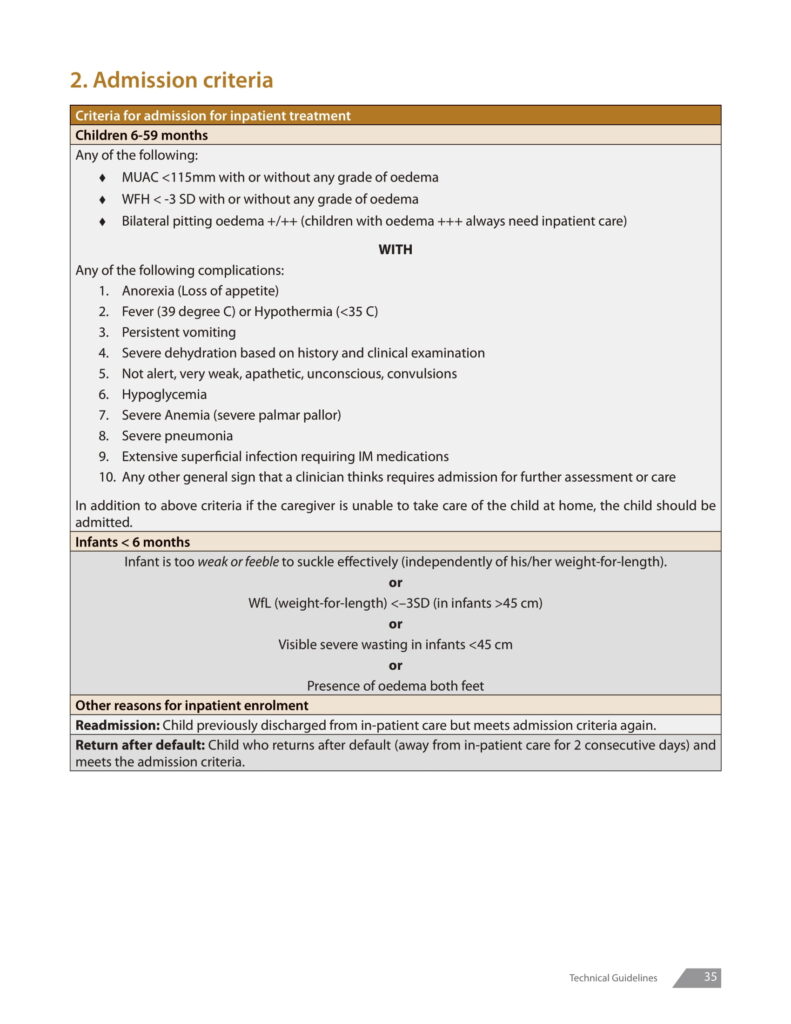Severe Acute Malnutrition
Definition
Severe acute malnutrition is defined by very low weight-for-height/length (Z-score below -3SD of the median WHO child growth standards), a mid-upper arm circumference <11.5 cm, or by the presence of nutritional oedema.
Children who are severely wasted are 9 times more likely to die than
well-nourished children.
Criteria
Hospital Admission Criteria
Admission Criteria for < 6 months age : if any one or more
- Severe Visible Wasting
- Bilateral Pitting Edema
- Weight for length < -3SD
- Infant is too weak or feeble to suck
Admission Criteria for 6 months to 59 months age : if any one or more
- Severe Visible Wasting
- Bilateral Pitting Edema
- Weight for length < -3SD
- Mid Upper Arm Circumference (MUAC)

Classification
Complicated SAM
- < 6 Months
- Not Alert
- Having Loss of Appetite
- > 6 Months but clinically not well
- Institutional Care is considered mandatory
Uncomplicated SAM
- > 6 Months of age
- Alert
- Preserved Appetite
- Clinically well
- Living in a conducive home environment
The majority of the deaths in the hospital occur within 24 hours of admission, many of these deaths can be prevented if the critically ill children are identified as soon as they are admitted and their treatment is started immediately.
History
- Recent intake of food and fluids
- Usual diet (before the current illness)
- Breastfeeding
- Duration and frequency of diarrhoea and vomiting
- Type of diarrhoea (watery/ bloody)
- Chronic cough
- Loss of appetite
- Family circumstances (to understand the child’s social background)
- Contact with tuberculosis
- Recent contact with measles
- Known or suspected HIV infection.
- Immunizations
Examination
- Anthropometry- weight, height/length, mid arm circumference
- Oedema
- Pulse, heart rate, respiratory rate
- Signs of dehydration
- Shock (cold hands, slow capillary refill, weak and rapid pulse)
- Palmar pallor
- Eye signs of vitamin A deficiency:
- Dry conjunctiva or cornea,
- Bitot’s spots
- Corneal ulceration
- Keratomalacia
- Localizing signs of infection, including ear and throat infections, skin
- infection or pneumonia
- Mouth ulcers
- Skin changes of kwashiorkor:
- Hypo or hyperpigmentation
- Desquamation
- Ulceration (spreading over limbs, thighs, genitalia, groin, and behind the ears)
- Exudative lesions (resembling severe burns) often with secondary infection (including Candida).
Investigation
- Blood glucose
- Haemoglobin or packed cell volume in children with severe palmar pallor
- Serum electrolytes eg; (sodium, potassium, and calcium whenever possible)
- Screening for infections:
- Total and differential leukocyte count, blood culture
- Urine routine examination
- Urine culture
- Chest x-ray
- Mantoux test
- Screening for HIV after counselling (only when suspected , based on history and clinical signs and symptoms)
- Any other specific test required based on geographical location or clinical presentation e.g. Celiac Disease, malaria etc.
Principles of hospital-based management
3 Phases
- Stabilization Phase,
- Transition Phase and
- Rehabilitative Phase.
Stabilization Phase : Children with SAM without an adequate appetite and/or a major medical complication are stabilized in an in-patient facility. This phase usually lasts for 1–2 days. The feeding formula used during this phase is Starter diet which promotes recovery of normal metabolic function and nutrition-electrolytic balance. All children must be carefully monitored for signs of overfeeding or over hydration in this phase.
Failure to Respond to Management
| Criteria | Approx. Day of admission |
| Failure to regain appetite | 4 |
| Failure to start to lose oedema | 4 |
| Oedema still present | 10 |
| Failure to gain at least 5 g/kg/day for 3 successive days after feeding freely on Catch-up diet |
Hospital Course
Discharge Criteria
Discharge the infant from the facility when gaining weight for 5 days and has no medical complications
Discharge Advice
Before Discharge :
- Explained how to prepare appropriate foods and to feed the child
- Explained how to give prescribed medications, vitamins, folic acid and iron at home
- Explained how to make appropriate toys and play with the child
- Explained how to give home treatment for diarrhoea, fever and acute respiratory infections and how to recognise the signs for which medical assistance must be sought
- Explained Follow-up plan
Medications :
Diet :
- To Register in Nearest NRC ( Nutritional Rehabilitation Centre)
- Give Home Made Food like Khichdi, Halwa
- if (Age <6months)
- Breast feed as often as the child wants, day and night, at least 8 times in 24 hours.
- Do not give any other foods or fluids not even water.
- if (Age 6 to 12 months)
- Breast feed as often as the child wants.
- Give at least one katori serving* at a time 3 times a day if breast feeding, 5 times a day if not breast feeding.
- if (Age 12 months to 2 Years)
- Breast feed as often as the child wants.
- Offer food from the family pot
- Give at least 1½ katori serving* at a time 3 times a day if breast feeding, 5 times a day if not breast feeding
- if ( 2 Years and older)
- Give family foods at 3 meals each day
- SERVINGS :
- Mashed roti/ rice/bread/ biscuit mixed in sweetened undiluted milk OR
- Mashed roti/rice/ bread mixed in thick dal with added ghee/oil or khichri with added oil/ghee. Add cooked vegetables also in the servings OR
- Sevian/dalia/halwa/ kheer prepared in milk or any cereal porridge cooked in milk OR
- Mashed boiled/ fried potatoes
- Also give nutritious food between meals, such as: banana/biscuit/ cheeko/mango/papaya as snacks ( for > 6 months)
General Advice For Mother-
- Wash your own and child’s hands with soap and water every time before feeding
- Play with the child for atleast 15 minutes 3 times a day
- good diet and micronutrient supplements to be taken by mother.